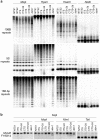Stress-induced activation of heterochromatic transcription
- PMID: 21060865
- PMCID: PMC2965753
- DOI: 10.1371/journal.pgen.1001175
Stress-induced activation of heterochromatic transcription
Abstract
Constitutive heterochromatin comprising the centromeric and telomeric parts of chromosomes includes DNA marked by high levels of methylation associated with histones modified by repressive marks. These epigenetic modifications silence transcription and ensure stable inheritance of this inert state. Although environmental cues can alter epigenetic marks and lead to modulation of the transcription of genes located in euchromatic parts of the chromosomes, there is no evidence that external stimuli can globally destabilize silencing of constitutive heterochromatin. We have found that heterochromatin-associated silencing in Arabidopsis plants subjected to a particular temperature regime is released in a genome-wide manner. This occurs without alteration of repressive epigenetic modifications and does not involve common epigenetic mechanisms. Such induced release of silencing is mostly transient, and rapid restoration of the silent state occurs without the involvement of factors known to be required for silencing initiation. Thus, our results reveal new regulatory aspects of transcriptional repression in constitutive heterochromatin and open up possibilities to identify the molecular mechanisms involved.
Conflict of interest statement
The authors have declared that no competing interests exist.
Figures






Similar articles
-
Epigenetic regulation of transcription in intermediate heterochromatin.EMBO Rep. 2006 Dec;7(12):1279-84. doi: 10.1038/sj.embor.7400835. Epub 2006 Nov 3. EMBO Rep. 2006. PMID: 17082818 Free PMC article.
-
Osmotic stress induces phosphorylation of histone H3 at threonine 3 in pericentromeric regions of Arabidopsis thaliana.Proc Natl Acad Sci U S A. 2015 Jul 7;112(27):8487-92. doi: 10.1073/pnas.1423325112. Epub 2015 Jun 22. Proc Natl Acad Sci U S A. 2015. PMID: 26100864 Free PMC article.
-
Replication-coupled histone H3.1 deposition determines nucleosome composition and heterochromatin dynamics during Arabidopsis seedling development.New Phytol. 2019 Jan;221(1):385-398. doi: 10.1111/nph.15248. Epub 2018 Jun 13. New Phytol. 2019. PMID: 29897636
-
Heterochromatin proteins and the control of heterochromatic gene silencing in Arabidopsis.J Plant Physiol. 2006 Feb;163(3):358-68. doi: 10.1016/j.jplph.2005.10.015. Epub 2005 Dec 27. J Plant Physiol. 2006. PMID: 16384625 Review.
-
Histone modification and the control of heterochromatic gene silencing in Drosophila.Chromosome Res. 2006;14(4):377-92. doi: 10.1007/s10577-006-1066-1. Chromosome Res. 2006. PMID: 16821134 Review.
Cited by
-
Chromosomal characteristics of salt stress heritable gene expression in the rice genome.BMC Genom Data. 2021 May 27;22(1):17. doi: 10.1186/s12863-021-00970-7. BMC Genom Data. 2021. PMID: 34044788 Free PMC article.
-
Epigenetics as an Evolutionary Tool for Centromere Flexibility.Genes (Basel). 2020 Jul 16;11(7):809. doi: 10.3390/genes11070809. Genes (Basel). 2020. PMID: 32708654 Free PMC article. Review.
-
Heat stress impairs centromere structure and segregation of meiotic chromosomes in Arabidopsis.Elife. 2024 Apr 17;12:RP90253. doi: 10.7554/eLife.90253. Elife. 2024. PMID: 38629825 Free PMC article.
-
Analysis of drought-responsive signalling network in two contrasting rice cultivars using transcriptome-based approach.Sci Rep. 2017 Feb 9;7:42131. doi: 10.1038/srep42131. Sci Rep. 2017. PMID: 28181537 Free PMC article.
-
Deep RNAseq indicates protective mechanisms of cold-tolerant indica rice plants during early vegetative stage.Plant Cell Rep. 2018 Feb;37(2):347-375. doi: 10.1007/s00299-017-2234-9. Epub 2017 Nov 18. Plant Cell Rep. 2018. PMID: 29151156
References
-
- Heitz E. Das Heterochromatin der Moose. Jahrb Wiss Botanik. 1928;69:762–818.
-
- Lander ES, Linton LM, Birren B, Nusbaum C, Zody MC, et al. Initial sequencing and analysis of the human genome. Nature. 2001;409:860–921. - PubMed
-
- The Chimpanzee Sequencing and Analysis Consortium. Initial sequence of the chimpanzee genome and comparison with the human genome. Nature. 2005;437:69–87. - PubMed
-
- Baucom RS, Estill JC, Chaparro C, Upshaw N, Jogi A, et al. Exceptional diversity, non-random distribution, and rapid evolution of retroelements in the B73 maize genome. PLoS Genet. 2009;5:e1000732. doi: 10.1371/journal.pgen.1000732. - DOI - PMC - PubMed
Publication types
MeSH terms
Substances
Associated data
- Actions
LinkOut - more resources
Full Text Sources
Other Literature Sources
Molecular Biology Databases

